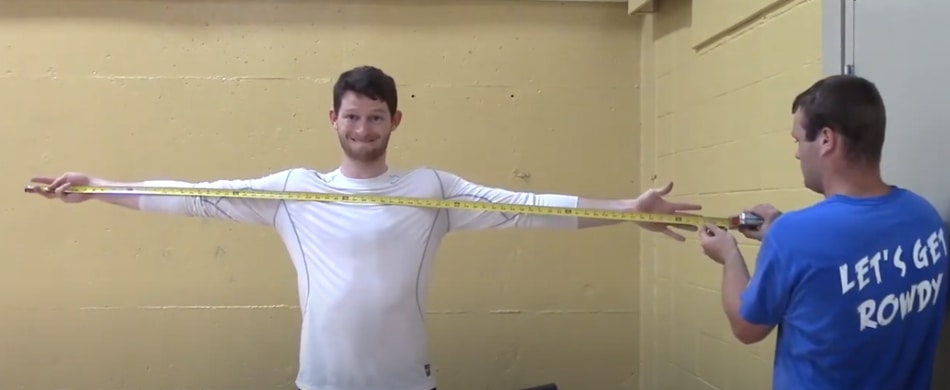
As a boxing fan or practitioner, you must have come across the word “reach” in your interactions with this amazing sport. Reach is one of the most crucial elements in boxing that determines a participant’s success in a tournament and is a personal statistic that every boxer needs to constantly be aware of, together with their weight and height.
Reach is the distance between a boxer’s right middle fingertip and the left middle fingertip when the arm is stretched perpendicular to one’s body (in a “T” shape) then measured across the chest and elbows. Reach is usually measured on a flat surface.
Normally, a boxer’s reach is positively correlated to his height, meaning that the taller you are, the longer your reach will be. But height isn’t the only factor. Long arms and a wide chest also contribute to the reach. That means sometimes a boxer can have a longer reach than his opponent even if he is shorter. But such cases are exceptions.
Boxers with a long reach can hit their opponent from a greater distance which means, taken on its own, long reach implies advantage, while short reach implies disadvantage over one’s opponent.
Six Steps to Accurately Measure Your Reach
Although you can measure your reach by yourself, having a friend to help with the measurement is key to obtaining accurate results. Like height and weight, boxers who understand their reach may have significant advantages over their opponents in the ring as it gives them insight into effective offensive or defensive techniques to apply in any given situation.
1. Remove clothes
The first step is to remove any upper body covering that may interfere with the results such as heavy clothing. For male boxers, I recommend measuring on a bare chest while the female boxers can keep on their sports bras as these do not cause any errors when taking the measurement.
2. Stretch and warm-up
Secondly, the body needs a few minutes of stretches and light activities such as rope skipping, light jogs, or fast walks. Or, you can engage in light cardio workouts such as swimming and cycling to improve your heart rate before measuring your reach. This warm-up is essential for relieving muscle congestion and improving your body’s flexibility and optimal reach.
3. Lie on a flat surface
Next, you have to find a flat surface – a wall or the ground – and lie with your back against the surface. Ensure to stretch both arms until they are parallel to the flat surface and at right angles with the rest of the body. In doing so, make sure that the back of your hands is resting on the wall while your palms face outward. During this procedure, a boxer needs to be comfortably rested to avoid movements that may result in errors in measurements.
4. T-shape
Align your body in such a way that by looking from the tip of the middle finger on the right-hand side, you can objectively ascertain that it is on a straight line with the tip of the middle finger of the left hand. If you notice any misalignment, try to adjust your positioning.
To get your true reach measurement, stretch your arms fully from the elbows and especially from the shoulders, which tend to “swallow” a few inches from your wingspan, thus denying you your optimum reach. When being helped by a friend, allow them to propose any changes to your alignment that they deem essential for giving you accurate reach results from their point of view.
5. Mark your measurements
Let your friend place a visible ink mark at the tip of both middle fingers on the flat wall or floor surface, and then release yourself and join them in taking the measurement. Your friend can then help to hold the zero mark of a tape measure on one marked point while you move towards the other end to note the exact measurement of your reach.
6. Record your reach
Finally, record your reach on a phone/computer or note it down on a piece of paper just in case you forget. You can store it in inches or centimeters depending on your region’s unit of measurement.
Why is Reach Important in Boxing
Boxers with a long reach can hit their opponent from a distance where their opponent can’t hit them back.
If you have a shorter reach, you may find it difficult to offend or defend against long-range punches such as jabs from an opponent with a long wingspan.
How long is “long reach,” and how short is “short reach?”
According to the World Boxing Association data, boxer’s reach is directly proportional to their weight class. But that’s because the heavier the weight class is, the taller the boxers are.
For example, heavyweight boxers (above 200 pounds) have an average reach of 76.3 inches, whereas strawweight, the boxers weighing up to 105 pounds, exhibit an average reach of 63.8 inches.
In that case, we can argue that anything longer than the average reach for your weight class is a long reach. If your measurements revealed a reach of more than 77 inches and you are a heavyweight, you have a long reach.
To find out which weight class you qualify for in boxing (middleweight, welterweight, featherweight, bantamweight, flyweight, or strawweight) and the average reach of those weight classes, check out my post on what is the average reach of a pro boxer (17 examples).
The difference between your reach and your opponent’s reach is called reach advantage and is worth considering when going to meet your opponent in the ring. However, you should not be discouraged by your opponent’s reach, as it is not the only factor that determines your success as a boxer.
In fact, with proper training on certain styles and techniques such as crossguards, lead uppercut jabs, and lead hooks to the body, head, or chin of your opponent, you may gain a significant advantage over your rival’s long reach.
Reach Exception
Not all tall boxers have a long reach, neither do all short boxers have a short reach. For instance, several boxers from low weight classes have repeatedly recorded longer reaches than some boxers in the heavyweight champions. Roger Mayweather, for example, was a featherweight boxer with an impressive reach of 73.5 inches that was longer than his heavyweight contemporaries such as Mike Tyson who has a reach of 71 inches.
This exception is attributed to the fact that reach includes the chest span. Therefore, a boxer may have a wide chest and short arms and have a longer reach. Or you may have a narrow chest and long arms but still, have a short reach.
Boxers With Long Reach and Their Style
The two-time world heavyweight champion Tyson Fury is a legendary boxer with a long reach. Fury, whose right-hand punch is considered one of the best boxers today, has a reach of 85 inches (216cm) and stands at a height of 206cm. Much of his confidence and success in facing most boxing record-holders are attributed to Fury’s wingspan and his boxing style.
Fury is unpredictable. Coupled with the years of experience he has in boxing, Fury has an amazing boxing IQ. He is known for his swift angular head movements (feints) and footwork, his constant experimentation with new fighting techniques, and his constant adaption to situations around him. But most importantly, Fury utilizes his long reach to disrupt his opponent’s rhythm and create hesitation, before dropping an unexpected jab.
Fury’s reach enables him to throw a variety of jabs including low jabs, straight jabs, and flick jabs, which are essential for his success in the ring. He uses these jabs to attack his opponents from strategic angles, alter the opponent’s timing and rhythm, and create an opportunity for occupying his guard.
He uses his reach advantage to create space and opportunity for him to control a fight, making Fury one of the most fascinating boxers to watch in a fight today.
Boxers With Short Reach and Their Style
Mike Tyson is the most famous short-reach boxer. That was because he was shorter than the heavyweight boxers at that time and had a reach of just 71 inches. But that never stopped him from knocking out opponents with longer reaches. For instance, just a few minutes into the fight, Tyson knocked down Eddie Richardson who has a reach of 77 inches.
Tyson falsified the theory that boxers with long reaches are the ones that dominate in fights to the disadvantage of short boxers.
How did he do it?
Mike Tyson is popular with the peek-a-boo style, where he keeps his hands over his face and makes quick moves. He hides behind his hands and uses them as shields against opponents’ blows. Then he would occasionally appear from behind his hands to confuse the reach-advantaged opponent, before suddenly pushing himself forward to extend his reach with a jab to knock out his rival.
To effectively implement the peek-a-boo style, you must never sacrifice your line of sight when you decide to raise your guard. Gain momentum from a combination of lateral, angular, and side-to-side head movements. The aim is to generate enough power for your jabs so that your hooks and uppercuts can have an extended reach that interrupts your opponent’s safe space.
Do this with a focus on the opponent’s head and body and you will create enough chances for employing devastating attacks whether you have a short or long reach.
However, the downside of peek-a-boo is that it demands a lot of energy and speed, and to use it, you must be explosive and fast and do a ton of grueling workouts.
If you have a short reach, peek-a-boo is a highly recommended style to implement in your fights because it helps you to quickly close up the distance between you and the opponent.
Reach and Arm Length in Boxing
Several boxers were reportedly involved in the intentional shortening of their reaches. They did this by failing to stretch out their arms to the peak when their reaches were measured so that they would have a reach advantage over their boxing weight classes.
The inconsistencies and exceptions attributed to a boxer’s reach compelled the WBA to devise a new strategy – arm length – for accurately determining the fighter who has a greater advantage over the others.
Unlike reach, a boxer’s arm length is the distance on one arm from your shoulder to the end of a clenched fist, making arm length very difficult to fake during measurements. This explains why arm length is commonly used when presenting boxers’ statistics, as it provides a clear indication of a fighter’s striking range.
Nevertheless, it is important to have both your reach and arm length measured and recorded to have a true idea of your boxing capacity.
Conclusion
Next time you are going to spar or maybe even fight in the ring, make sure you notice if your opponent has a longer reach than you.
If they show a significant reach advantage over you, the best technique to remember is Mike Tyson’s peek-a-boo. Give them incredible footwork and guard your head under your arms while ensuring you do not lose your line of sight. Most importantly, close into the opponent and avoid staying far from them since you would be in their area of strength.
But if you have a longer reach, make sure that you maintain a safe space by keeping the boxer as far to your area of strength as possible. Use feints to maneuver and trick your opponent before sending quick jabs to set up your straight right hand.



